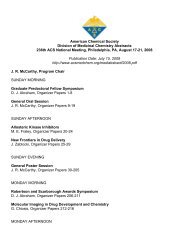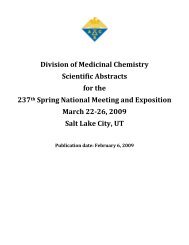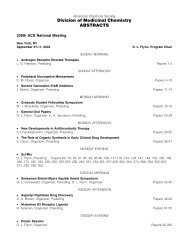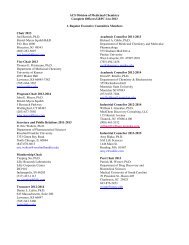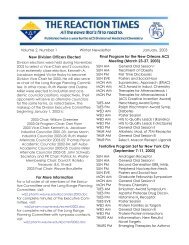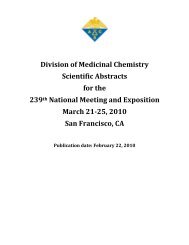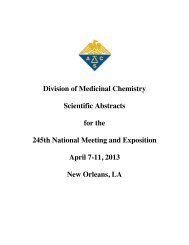Division of Medicinal Chemistry Abstracts-235th ACS National ...
Division of Medicinal Chemistry Abstracts-235th ACS National ...
Division of Medicinal Chemistry Abstracts-235th ACS National ...
- No tags were found...
You also want an ePaper? Increase the reach of your titles
YUMPU automatically turns print PDFs into web optimized ePapers that Google loves.
MEDI 11<br />
Calcitonin gene-related peptide (CGRP) receptor antagonists for the treatment <strong>of</strong><br />
migraine: Development <strong>of</strong> orally bioavailable imidazoazepanes<br />
Daniel V. Paone, Department <strong>of</strong> <strong>Medicinal</strong> <strong>Chemistry</strong>, Merck Research Laboratories, 770<br />
Sumneytown Pike, West Point, PA 19486, daniel_paone@merck.com<br />
Calcitonin gene-related peptide (CGRP) is a 37 amino acid neuropeptide that has been<br />
implicated in the pathogenesis <strong>of</strong> migraine. Since CGRP receptor antagonists promote<br />
normalization <strong>of</strong> dilated blood vessels through a non-vasoconstrictive mechanism, this class <strong>of</strong><br />
compounds could prove effective in the relief <strong>of</strong> migraine without the adverse cardiovascular<br />
effects that are sometimes associated with existing therapies. Our research program targeted<br />
non-peptide, orally bioavailable CGRP receptor antagonists culminating in the discovery <strong>of</strong><br />
caprolactam-azabenzimidazolone MK-0974, which has recently demonstrated efficacy in a<br />
Phase IIb clinical trial. Targeted areas for improvement in our backup program include aqueous<br />
solubility, in vivo potency, and rhesus pharmacokinetics. We have identified a series <strong>of</strong><br />
imidazoazepanes which demonstrate improved potency and aqueous solubility. Concurrently,<br />
an investigation <strong>of</strong> replacements for the metabolically labile azabenzimidazolone <strong>of</strong> MK-0974<br />
has produced a series <strong>of</strong> spiropiperidines with superior pharmacokinetic pr<strong>of</strong>iles. This strategy<br />
ultimately resulted in the identification <strong>of</strong> backup MK-2918.<br />
MEDI 12<br />
Novel series <strong>of</strong> CB2 selective agonists for the treatment <strong>of</strong> neuropathic pain<br />
Philippe Diaz, Jijun Xu, Fanny Astruc Diaz, Hao-Min Pan, and Mohamed Naguib,<br />
Anesthesiology and Pain Medicine - Research, The University <strong>of</strong> Texas M.D. Anderson Cancer<br />
Center, Unit 110, 1515 Holcombe Blvd, Houston, TX 77030, Fax: 713-794-4590,<br />
pdiaz@mdanderson.org<br />
Neuropathic pain, a debilitating condition characterized by severe, persistent pain that is<br />
refractory to traditional analgesia, results from heterogeneous conditions affecting the peripheral<br />
or central nervous system (CNS) and affects an estimated 8% <strong>of</strong> people worldwide. The<br />
cannabinoid receptor CB2, has emerged as a new target for the treatment <strong>of</strong> pain without the<br />
CB1 mediated psychotropic side effects. Two series <strong>of</strong> novel cannabinoid modulators based on<br />
two heterocyclic scaffolds, have been synthesized. Highly potent and selective CB2 agonists<br />
were identified in both series using in vitro binding and functional assays. Selected compounds<br />
were tested in vivo relevant models <strong>of</strong> neuropathic pain and were able to reverse allodynia and<br />
hyperalgesia, with no visible CNS side effects. In contrast, a CB1–CB2 agonist, Win 55,212,<br />
caused rigidity, spasm, and lethargy. Details <strong>of</strong> the synthesis, CB1 and CB2 receptors structureactivity<br />
relationships, in vitro, and in vivo data will be presented.



